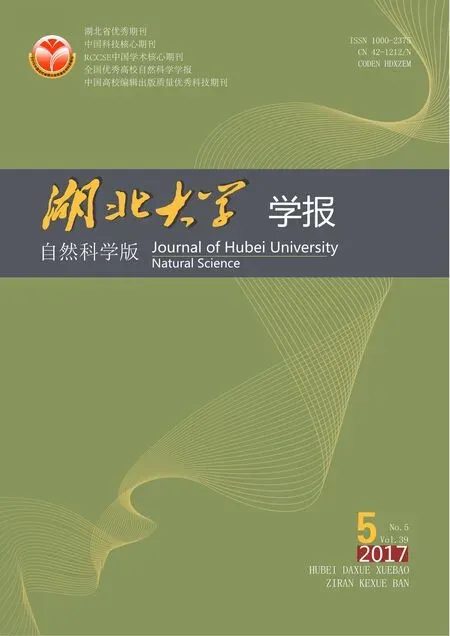不同烧结温度对多铁陶瓷Bi5Ti3FeO15磁电性能的影响
余中辉,余博源,祁亚军,梁坤,马志军,章天金
(湖北大学材料科学与工程学院,湖北 武汉 430062)
不同烧结温度对多铁陶瓷Bi5Ti3FeO15磁电性能的影响
余中辉,余博源,祁亚军,梁坤,马志军,章天金
(湖北大学材料科学与工程学院,湖北 武汉 430062)
以TiO2、Fe2O3和Bi2O3为原料,采用固相反应法分别在975、1 000、1 025、1 050 ℃下烧结制备Bi5Ti3FeO15(BTFO)多铁陶瓷.X线衍射结果显示,不同烧结温度制备的BFTO陶瓷均为单一的层状钙钛矿相.随着烧结温度的升高,BTFO陶瓷的晶粒尺寸增大,致密度提高.扫描电镜的结果表明1 050 ℃烧结的陶瓷样品,晶粒尺寸约为15 μm,具有最大的剩余极化Pr值18.6 μC/cm2. BTFO陶瓷在室温下为顺磁性,同时具有一定的磁电耦合特性,磁场为725 Oe、频率50 Hz下测得的磁电耦合系数达到3.7 mV/cm Oe.
烧结温度;晶粒尺寸;剩余极化;磁电耦合
0 引言
单相多铁材料同时具有铁电性和铁磁性,在传感器、自旋电子学和信息存储等方面都有潜在的应用价值,因而在近些年备受关注[1-3]. 然而,同时具有铁电性和铁磁性的化合物又十分有限,如:BiFeO3和BiMnO3[4-5]. BiFeO3室温下具有铁电性和弱铁磁性,其铁电居里温度(TC)约为 1 100 K,反铁电性的奈尔温度(TN)约为 640 K,但它具有大的漏电流和室温下弱的铁磁性等弱点使得不能得到广泛应用[6-7]. 将具有不同功能的单元融入同一材料的晶体结构中在单相材料中是实现铁电性和铁磁性共存的一种有效办法,一种单元保证铁电性,而另一种单元保证铁磁性. Singh在1994年向三层Bi系钙钛矿结构的铁电材料Bi4Ti3O12中成功引入BiFeO3进而形成Bi5Ti3FeO15(BTFO)这类新型的层状结构的单相多铁材料[8].Bi5Ti3FeO15在室温下是四方晶体结构,属于A21am空间群,铁电-顺电相的转变温度为1 003 K 左右,对应的空间群从A21am转变到I4/mmm[9].Bi5Ti3FeO15属于四层铋系Aurivillus化合物,可看做由铋氧层(Bi2O2)2+和三层类钙钛矿层(Am-1BmO3m+1)2-沿c轴方向交替排列而成[10].其中m值一般是整数;A位离子可以是Na、K、Bi、Ba、Sr、Ca以及镧系金属等; B位离子处于BO6八面体的中心位置,可以是Ti、Fe、W以及过渡金属等.铋氧层(Bi2O2)2+单元是一种类萤石的结构,(Am-1BmO3m+1)2-单元是一种类钙钛矿的结构,接在(Am-1BmO3m+1)2-单元两端整体形成一种类似三明治的结构,因此这种层状的钙钛矿结构与简单的钙钛矿结构如BiFeO3相比在结构上增加了铋氧层(Bi2O2)2+单元.铋氧层具有空间电荷库和绝缘层的作用,可以减小漏电流和疲劳性能的影响,从而保证BTFO在室温下的铁电性[11]. BFTO的一系列化合物可以用通式Bim+1Ti3Fem-3O3m+3来表示,m=4时,表示的就是BFTO,它具有自发极化Ps大、矫顽场Ec小以及抗疲劳性能优等特点[12-18].
BTFO的铁电性和铁磁性在近些年得到了广泛的研究[10,19]. Zhao等人通过静电纺丝制备的BFTO纳米纤维,剩余极化Pr仅有0.04 μC/cm2[20]. Mao等通过Co对Fe的取代采用两步合成法制备得到Bi5Fe0.5Co0.5Ti3O15(BFCTO)陶瓷,以及La和Co共掺杂取代得到Bi4. 25La0. 75Fe0. 5Co0. 5Ti3O15(BLFCT)陶瓷样品,使其铁电性得到提高,剩余极化Pr达到6.5 μC/cm2[21-22].Liu等人用不同量的Cr对Fe的取代,采用传统固相反应法制备得到的Bi5Ti3FeO15陶瓷Pr达到7.2 μC/cm2,能够耐受的最大电场为115 kV/cm[23-24].在铋层状结构的多铁材料中,铁电性是重要的性能之一. 已有的报道显示,BFTO系列多铁陶瓷样品的剩余极化很少超过10 μC/cm2.
因此,本工作采用传统固相反应法,优化陶瓷样品的制备工艺,探求陶瓷样品的最佳烧结温度,寻找最佳晶粒尺寸,提高陶瓷样品的致密度,减小漏电流,提升击穿电压,从而改善样品的铁电性将具有重要意义. 本文中从不同的烧结温度以及对应的晶粒尺寸变化探讨其对铁电性的影响.
1 实验方法
采用传统固相反应法制备Bi5Ti3FeO15多铁陶瓷样品.以TiO2、Fe2O3和Bi2O3(纯度≥99%)为原料,按照化学计量比称取原料后置于尼龙球磨罐内,以无水乙醇为介质用行星式球磨机球磨8 h. 待混合物烘干后,在850 ℃下预烧6 h. 二次球磨后烘干,加入PVA作粘结剂后,将预烧产物压片至1 mm. 在550 ℃下排胶2 h后,随炉冷却. 薄片分别在975、1 000、1 025、1 050 ℃下烧结4 h后,自然冷却,得到陶瓷样品. 将陶瓷样品磨薄至0.2mm后进行表面抛光处理,采用磁控溅射法镀Pt电极后,进行性能的测试.
用X线(Bruker D8 Advance, Cu-Kα1radiation)分析样品的晶体结构,场发射扫描电镜(FE-SEM, JSM7100F)探测样品的微观形貌. 采用铁电测试仪(Radiant Technology Precision LC precision materials analyzer)检测室温下样品的铁电性能.采用物性测试仪PPMS测试陶瓷样品的磁学特性.
2 结果与讨论
图1显示BFTO在室温下的XRD图谱. XRD的测试结果表明所有BTFO陶瓷样品结晶良好,均形成了四层铋系钙钛矿相,没有第二相生成. 所有衍射峰位基本一致,说明烧结温度的变化并没有使得他们的晶型发生改变,他们均属于A21am的正交晶系空间群. 所有样品的衍射峰均为(119)最强,说明样品均为随机取向. 选取其中1 050 ℃烧结的陶瓷样品,通过TOPAS软件对衍射结果进行精修得到陶瓷样品的晶格常数为a=0.546 21 nm、b=0.436 nm、c=4.128 01 nm,这和之前的报道接近[12].
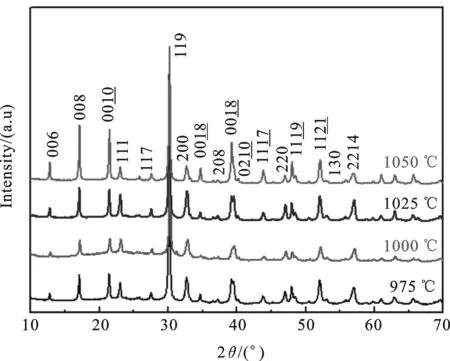
图1 不同烧结温度下BTFO陶瓷样品的XRD图
图2为不同烧结温度下陶瓷样品的断面SEM图像. 因为Aurivillius化合物晶体结构的各向异性,对于BTFO陶瓷而言,晶格a、b长度相当,晶格c的长度为晶格a、b长度的8倍. 这使得原子在ab面内的扩散速度要远远大于沿c轴方向的扩散速度,所以晶体呈出现片状形貌[25]. 从SEM图像中可以观测到,975 ℃烧结的陶瓷样品尚有部分孔洞,晶粒尺寸并不足够大,样品不够致密. 随着烧结温度的升高,晶粒逐渐长大,逐渐填充孔洞,在1 050 ℃烧结的陶瓷样品孔洞逐渐减少,晶粒尺寸增大,在15 μm左右时,样品致密度高. 由此可见,陶瓷样品的烧结温度对晶粒的大小有着至关重要的影响.

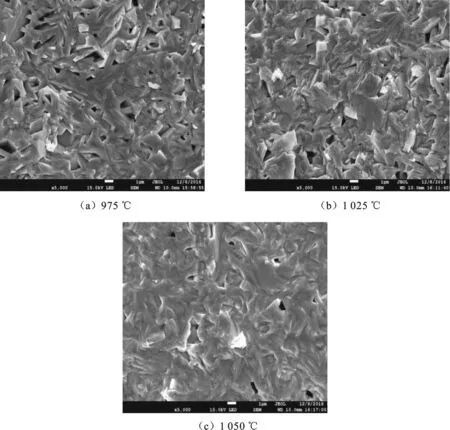
图2 不同温度烧结的BFTO陶瓷样品的
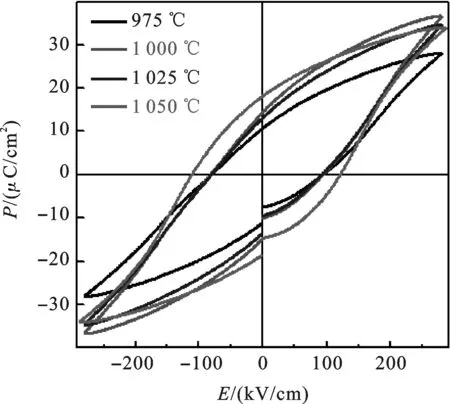
图3 BTFO陶瓷样品在室温下的铁电回线
为了探讨BTFO陶瓷铁电性增加机理,我们研究了晶粒尺寸及烧结温度与对铁电性的关联. 从图2和图3中可以看出,随着烧结温度升高,晶粒长大,气孔减少,致密度提高,耐压性提高,剩余极化增大. 体系的剩余极化主要来自离子的位移极化,陶瓷样品的致密度增加有助于提高体系的离子位移极化从而增强其铁电性.从图2可以看出BTFO陶瓷烧结温度在1 050 ℃时,对应晶粒尺寸在15 μm左右,样品致密更高,气孔较少,因而具有更好的铁电性.
图4给出的1 050 ℃烧结的BTFO陶瓷样品在室温下的磁滞回线.M-H曲线并无明显的滞后现象,这种近似直线的M-H关系体现了BTFO陶瓷在室温时剩余磁化较弱. 这一结果和Dong等人制备的BTFO陶瓷类似[10].其主要原因是因为铁离子和钛离子随机分布,从而形成了Fe-O团簇,相邻的Fe-O团簇就形成的Fe-O-Fe耦合是反铁磁(AFM)耦合,因此BTFO表现为一种AFM相互作用背景下的超顺磁态[11]. 铁磁性弱的原因可能在于Fe元素绝大部分以Fe3+的形式存在,很少以Fe2+形式存在,从而使得Fe3+—O— Fe2+铁磁耦合难以形成. 同时,BFTO陶瓷具有较强的电学性能和较弱的磁学性能,这可能是由于磁电相互制约的结果所导致[28].

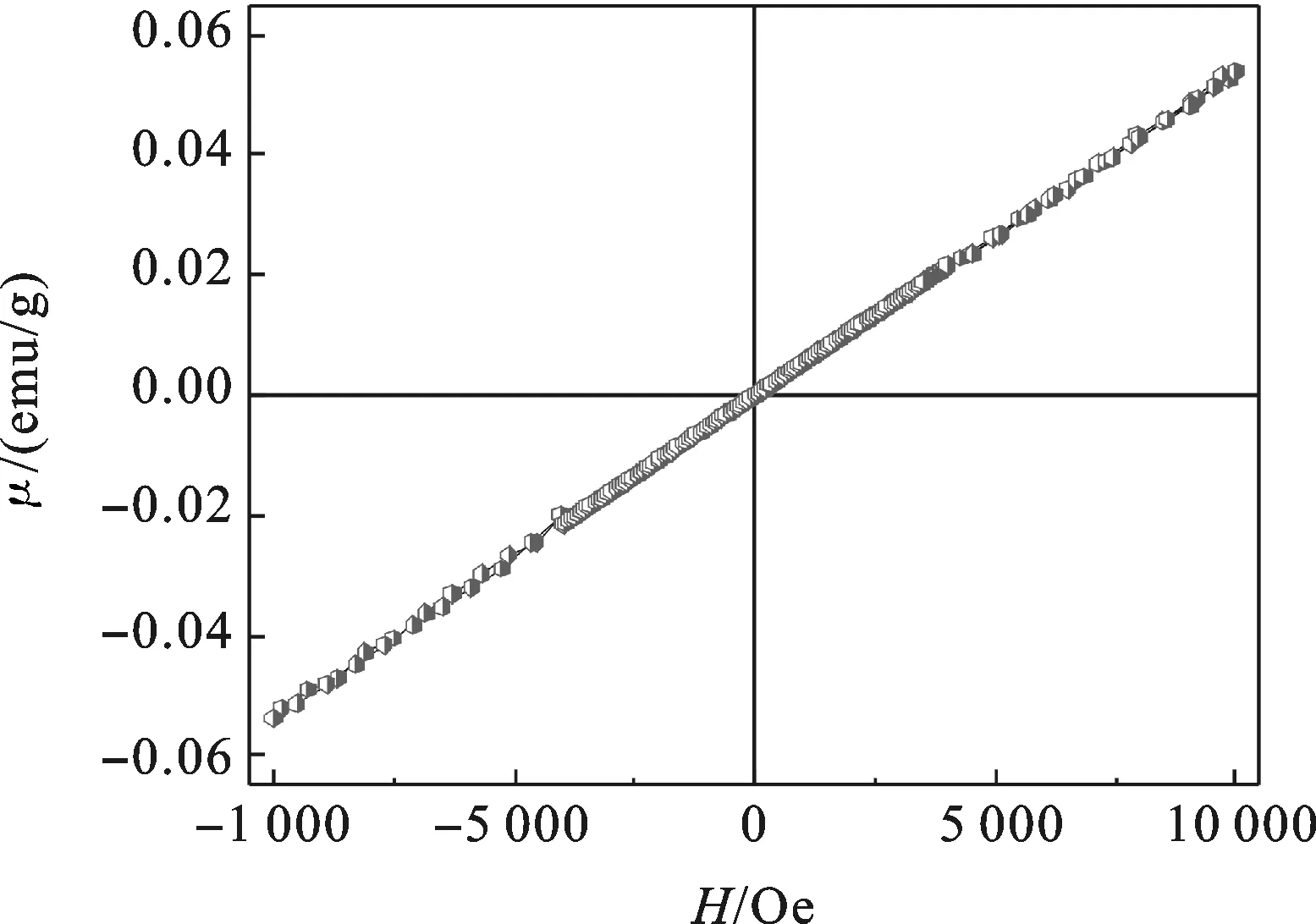
图4 在1 050 ℃下烧结的BFTO陶瓷样品在室温下的磁滞回
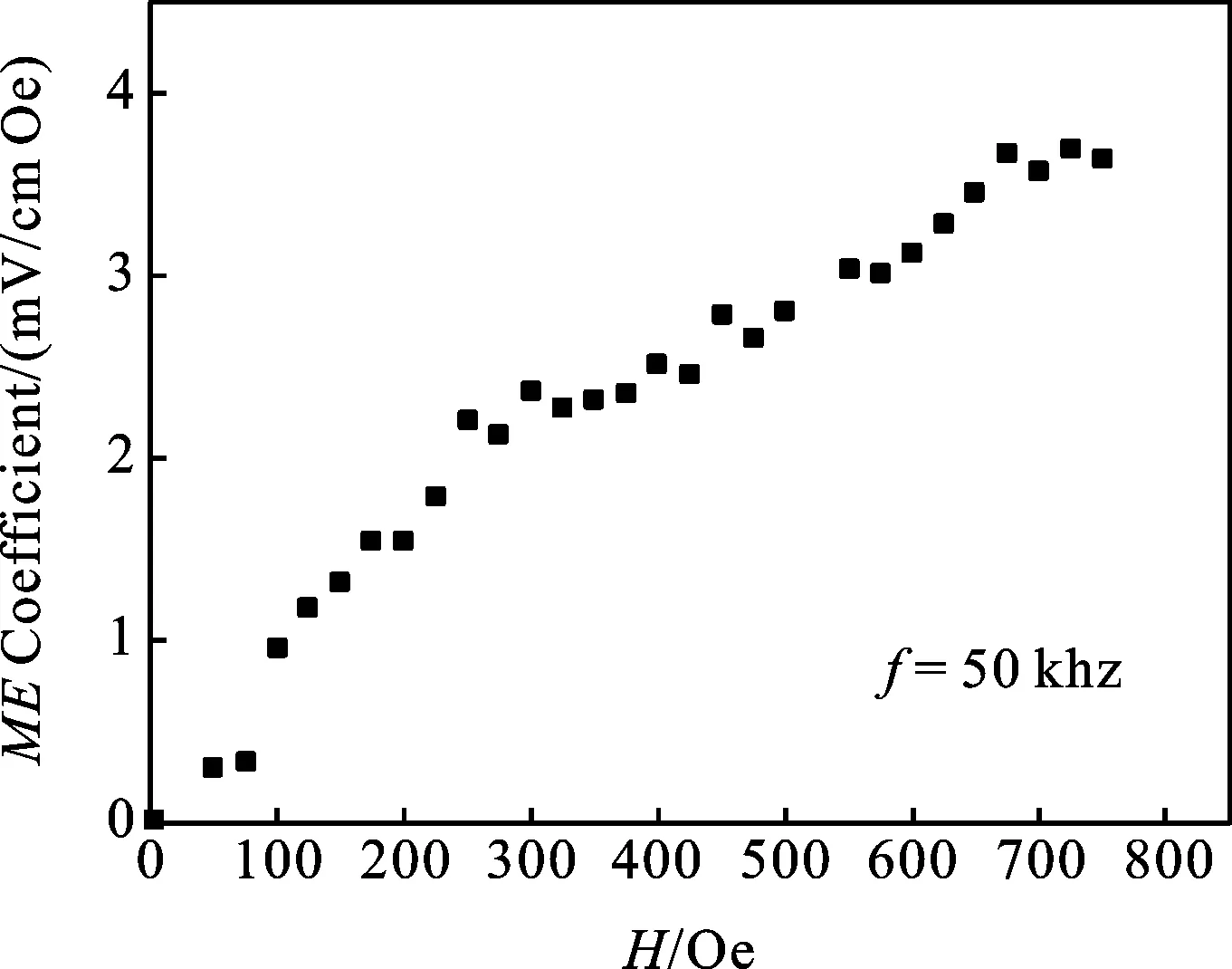
图5 在1 050 ℃下烧结的BTFO陶瓷样品在室温下的磁电耦合系数随磁场变化曲
3 结论
采用固相固相反应法制备BFTO陶瓷,在975 ℃、1 000 ℃、1 025 ℃、1 050 ℃下进行烧结,结构与电学性能研究结果表明:1 050 ℃左右烧结的陶瓷样品的晶粒尺寸更大,样品致密度更高,铁电性能更好,剩余极化Pr为18. 6 μC/cm2. BTFO陶瓷样品的晶粒尺寸在15 μm左右时,具有良好的铁电性.BTFO陶瓷样品在室温时铁磁性很弱,这可能与样品中没有形成Fe3+—O— Fe2+耦合有关. 测试频率为50 kHz、外磁场为745 Oe时,BTFO陶瓷样品在室温下的磁电耦合系数为3.7 mV/cm Oe.BTFO陶瓷样品具有一定的磁电耦合特性说明体系在外磁场作用的磁致伸缩导致内部应变传递,但磁电耦合系数较小可能与样品的铁磁性很弱有关.
[1] Eerenstein W, Mathur N D, Scott J F.Multiferroic and magnetoelectric materials[J].Nature, 2006,442:759.
[2] Cheong S W and Mostovoy M. Multiferroics: a magnetic twist for ferroelecity[J]. Nat Mater, 2007,6:13.
[3] Ramesh R and Spaldin N A. Multiferroics: progress and prospects in films[J].Nat Mater, 2007,6, 21.
[4] Wang J, Neaton J B, Zheng H, et al. Epitaxial BiFeO3multiferroic thin hetero strutures[J].Science, 2003,299:1719.
[5] Kimura T, Kawamoto S, Yamada Y, et al. Magnetocapacitance effect in multiferroic BiMnO3[J].Phys Rev B, 2003,67:180401(R).
[6] Song W, Wang X, Zhang D, et al. Preparation and characterization of multiferroics BiFeO3[J].Journal of Inorganic Materials, 2012,27(10): 1053-1057.
[7] Das S R, Choudhary R N P, Bhattacharya P, et al. Structural and multiferroic properties of La-modified BiFeO3ceramics[J].J Appl Phys, 2007,101(3): 034104-1-7.
[8] Singh R S, Bhimasankaram T, Kumar GS, et al.Dielectric and magnetoelectric properties of Bi5FeTi3O15[J]. Solid State Commun,1994,91:567.
[9] Snedden A, Hervoches C H, Lightfoot P. Ferroelectric phase transitions in SrBi2Nb2O9and Bi5Ti3FeO15: a powder neutron diffraction study[J]. Phys Rev B, 2003, 67: 092102.
[10] Dong X W, Wang K F, Wang J G, et al. Magnetocapacitance of polycrystalline Bi5Ti3FeO15prepared by Sol-Gel method[J].J Appl Phys,2008,103(9):1-4.
[11] Kim S K, Miyayama M, Yanagida H. Electrical anisotropy and a plausible explanation for dielectric anomaly of Bi4Ti3O12single crystal[J]. Mater Res Bull, 1996, 31: 121.
[12] Aurivillius B.Mixed bismuth oxides with layer lattices:Ⅰ[J].Ark Kemi, 1949,1(1):463-471.
[13] Smolenskii G A, Isupov V A, Agranovskaya A I.A new group of ferroelectrics (with layered structure):Ⅰ[J].Fiz Tverd Tela(Leningrad),1959,1(1):169-170.
[14] Smolenskii G A, Isupov V A, Agranovskaya A I.A new group of ferroelectrics (with layered structure):Ⅱ[J].Fiz Tverd Tela (Leningrad),1963,3(3):896-901.
[15] Boullay P, Trolliard G, Mercurio D.Toward a unified approach to the crystal chemistry of aurivillius-typecompounds(Ⅰ):the structural model[J].J Solid State Chem, 2002,164(2):252-260.
[16] Garcia-Guaderrama M, Fuentes L, Montero M E, et al.Molten salt synthesis and crystal structure of Bi5Ti3FeO15[J].Integrated Ferroelectrics, 2005,71:233-239.
[17] Snedden Alan, Hervoches Charles H, Lightfoot Philip. Ferroelectric phase transitions in SrBi2Nb2O9and Bi5Ti3FeO15:a powder neutron diffraction study[J].Phy Rev, 2003,B67(9):092102.
[18] Fuentes L, Garcia M, Bueno D, et al.Magnetoelectric effect in Bi5Ti3FeO15ceramics obtained by molten salts synthesis[J].Ferroelectrics, 2006, 336(1):81-89.
[19] Srinivas A, Suryanarayana S V, Kumar G S, et al. Magnetoelectric measurements on Bi5Ti3FeO15and Bi6Fe2Ti3O18[J].J Phys: Condens Matter,1999,11:3335.
[20] Zhao Y W, Fan H Q, Liu G C, et al.Ferroelectric, piezoelectric properties and magnetoelectric coupling behavior in aurivillius Bi5Ti3FeO15multiferroic nanofibers by electrospinning[J].Journal of Alloys and Compounds, 2016, 675:441-447.
[21] Mao X Y, Wang W, Sun H, et al. Influence of different synthesizing steps on the multiferroic properties of Bi5Ti3FeO15and Bi5Fe0.5Co0.5Ti3O15ceramics[J].J Mater Sci, 2012,47(6): 2960-2965.
[22] Mao X Y, Sun H, Chen X B, et al. Ferromagnetic, ferroelectric properties, and magneto-dielectric effect of Bi4. 25La0. 75Fe0.5Co0.5Ti3O15ceramics[J].Appl Phys Lett, 2013,102: 072904.
[23] Liu Z, Yang J, Tang X W, et al. Multiferroic properties of aurivillius phase Bi6Fe2-xCoxTi3O18thin films prepared by a chemical solution deposition route[J].Appl Phys Lett, 2012,101:122402.
[24] Liu J, Bai W, Yang J, et al.The Cr-substitution concentration dependence of the structural, electric and magnetic behaviors for Aurivillius Bi5Ti3FeO15multiferroic ceramics[J]. J Appl Phys,2013,114:234101.
[25] Mao X Y, Wang W, Chen X B. Electrical and magnetic properties of Bi5Ti3FeO15compound prepared by inserting BiFeO3into Bi4Ti3O12[J]. Solid State Communications, 2008,147(5/6):186-189.
[26] Bai W, Gao Y Q, Zhu J Y, et al. Electrical, magnetic, and optical properties in multiferroic Bi5Ti3FeO15thin films prepared by a chemical solution deposition route[J].J Appl Phys, 2011,109:064901.
[27] Nakashima S, Nakamura Y, Yun K Y, et al. Preparation and characterization of Bi-layer-structured multiferroic Bi5Ti3FeO15thin films prepared by pulsed laser deposition[J]. J Appl Phys Part 1, 2007, 46:6952.
[28] Hill N A.Why are there so few magnetic ferroelectrics?[J].J Phys Chem B, 2000,104(29):6694-6709.
(责任编辑 胡小洋)
The magnetic and electrical properties ofmultiferroic ceramics Bi5Ti3FeO15sintered at various temperatures
YU Zhonghui, YU Boyuan, QI Yajun, LIANG Kun,MA Zhijun, ZHANG Tianjin
(Faculty of Materials Science and Engineering, Hubei University, Wuhan 430062, China)
Bi5Ti3FeO15(BTFO) multiferroic ceramics were prepared by solid state reaction method using TiO2, Fe2O3and Bi2O3powders as raw materials.The sintering temperatures were 975 ℃、1 000 ℃、1 025 ℃、1 050 ℃, respectively. The results of X-ray diffraction indicate all samples at different sintering temperatures are single-phase bismuth layered perovskites. With the increase of sintering temperature, the BTFO ceramics exhibit high density and large grain size. Scanning electron microscopy result shows that the grain size of BTFO ceramic sintered at 1 050 ℃ is approximately 15 μm. The largest remnant polarization of these prepared ceramics is about 18.6 μC/cm2. BTFO ceramics show a paramagnetic feature at room temperature.The magnetoelectric coupling coefficient were measured to be 3.7 mV/cm Oe at 50 Hz and H=800 Oe for the BTFO ceramics sintered at 1 050 ℃.
sintering temperature, grain size, remnant polarization, magnetoelectric coupling
2017-02-23
国家自然科学基金(51472078,51372074,11574073)资助
余中辉(1995-),男,本科生;梁坤,通信作者,副教授,研究方向:多铁材料,E-mail:liangkun@hubu.edu.cn
1000-2375(2017)05-0491-05
TB303
A
10.3969/j.issn.1000-2375.2017.05.010

